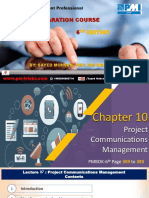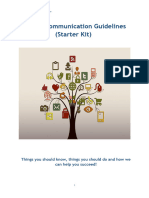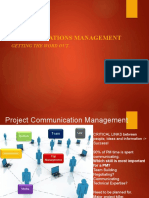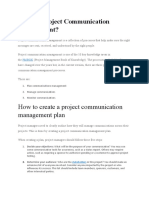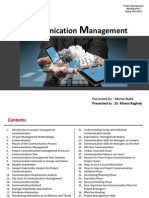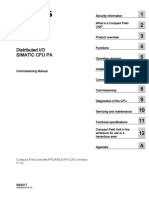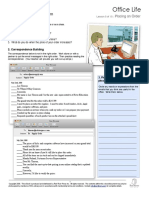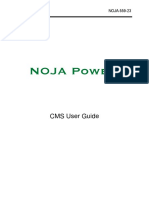Communications
Communications
Uploaded by
petermamdouhraoufCopyright:
Available Formats
Communications
Communications
Uploaded by
petermamdouhraoufOriginal Description:
Copyright
Available Formats
Share this document
Did you find this document useful?
Is this content inappropriate?
Copyright:
Available Formats
Communications
Communications
Uploaded by
petermamdouhraoufCopyright:
Available Formats
Project Communications Management
PMP Exam Prep Course
PMI PMBoK 6th Edition
Project Communications Management
Nagy A. Saad
Orange Restricted
Agenda 2
1 2 3 4
Overview of Plan Manage Monitor
Communications
Communications Communications Communications
Management Management
Orange Restricted
PMP Course by Nagy Saad – PMBOK 6th edition
Project Communications Management
Project Communications Management 3
> Its not about “What You Say”, it’s about “How you Say It” !!
Orange Restricted
Project Communications Management
Orange Restricted
PMP Course by Nagy Saad – PMBOK 6th edition
Project Communications Management
Project Communications Management 5
> Project Communications Management includes the processes necessary to
ensure that the information needs of the project and its stakeholders are
met through development of artifacts and implementation of activities
designed to achieve effective information exchange.
Orange Restricted
Project Communications Management 6
> Project Communications Management consists of two parts.
1. Developing a strategy to ensure communication is effective for stakeholders.
2. Carrying out the activities necessary to implement the communication
strategy.
> Plan Communications Management—The process of developing an appropriate
approach and plan for project communication activities based on the information
needs of each stakeholder or group, available organizational assets, and the needs
of the project.
> Manage Communications—The process of ensuring timely and appropriate
collection, creation, distribution, storage, retrieval, management, monitoring, and
the ultimate disposition of project information.
> Monitor Communications—The process of ensuring the information needs of the
project and its stakeholders are met.
Orange Restricted
PMP Course by Nagy Saad – PMBOK 6th edition
Project Communications Management
Key Concepts 7
> Communications describe the possible means by which the information can
be sent or received,
₋ Either through communication activities, such as meetings and
presentations,
₋ Or artifacts, such as emails, social media, reports, or documentation.
> Project managers spend most of their time communicating with team
members and other project stakeholders, both internal (at all organizational
levels) and external to the organization. (almost 90% of his/her time).
Orange Restricted
Communication Dimensions 8
> Internal. Focus on stakeholders within the project and within the
organization.
> External. Focus on external stakeholders such as customers, vendors, other
projects, organizations, government, the public, and environmental
advocates.
> Formal. Reports, formal meetings (both regular and ad hoc), meeting
agendas and minutes, stakeholder briefings, and presentations.
> Informal. General communications activities using emails, social media,
websites, and informal ad hoc discussions.
Orange Restricted
PMP Course by Nagy Saad – PMBOK 6th edition
Project Communications Management
Communication Dimensions 9
> Hierarchical focus. The position of the stakeholder or group with respect to
the project team will affect the format and content of the message:
₋ Upward. Senior management stakeholders.
₋ Downward. The team and others who will contribute to the project
work.
₋ Horizontal. Peers of the project manager or team.
> Official. Annual reports; reports to regulators or government bodies.
> Unofficial. Communications that focus on establishing and maintaining the
profile and recognition of the project and building strong relationships
between the project team and its stakeholders using flexible and often
informal means.
Orange Restricted
Communication Dimensions 10
> Written and oral. Verbal (words and voice inflections) and nonverbal (body
language and actions), social media and websites, media releases.
Orange Restricted
PMP Course by Nagy Saad – PMBOK 6th edition
Project Communications Management
Communication Dimensions 11
Orange Restricted
Key Concepts 12
> Misunderstandings can be reduced using the 5Cs of written communications:
1. Correct grammar and spelling. Poor use of grammar or inaccurate spelling
can be distracting and can also introduce distortions in the message.
2. Concise expression and elimination of excess words. A concise, well-crafted
message reduces the opportunities for misunderstanding the intent of the
message.
3. Clear purpose and expression directed to the needs of the reader. Ensure
that the needs and interests of the audience are factored into the message.
4. Coherent logical flow of ideas. A coherent logical flow of ideas and using
“markers” such as introduction and summaries of the ideas.
5. Controlling flow of words and ideas. Controlling the flow of words and ideas
may involve graphics or just summaries.
Orange Restricted
PMP Course by Nagy Saad – PMBOK 6th edition
Project Communications Management
Key Concepts 13
Orange Restricted
Trends and Emerging Practices 14
> Inclusion of stakeholders in project reviews. The stakeholder community
of each project includes individuals, groups, and organizations that the
project team has identified as essential to the successful delivery of project
objectives and organizational outcomes. An effective communication
strategy requires regular and timely reviews of the stakeholder community
and updates to manage changes in its membership and attitudes.
> Inclusion of stakeholders in project meetings. Project meetings should
include stakeholders from outside the project and even the organization,
where appropriate. Practices inherent in the agile approaches can be
applied to all types of projects. Practices often include short, daily standup
meetings, where the achievements and issues of the previous day, and
plans for the current day’s work, are discussed with the project team and
key stakeholders.
Orange Restricted
PMP Course by Nagy Saad – PMBOK 6th edition
Project Communications Management
Trends and Emerging Practices 15
> Increased use of social computing. Social computing in the form of infrastructure,
social media services, and personal devices has changed how organizations and
their people communicate and do business. Social computing incorporates
different approaches to collaboration supported by public IT infrastructure. Social
networking refers to how users build networks of relationships to explore their
interests and activities with others.
> Multifaceted approaches to communication. The standard communication
strategy for project stakeholder communications embraces and selects from all
technologies and respects cultural, practical, and personal preferences for
language, media, content, and delivery. When appropriate, social media and other
advanced computing technologies may be included. Multifaceted approaches such
as these are more effective for communicating to stakeholders from different
generations and cultures.
Orange Restricted
Plan Communications 16
Management
Orange Restricted
PMP Course by Nagy Saad – PMBOK 6th edition
Project Communications Management
Plan Communications Management 17
> Plan Communications Management:
1. Who
2. What
3. Format
4. Tool
5. When
6. Frequency
7. Responsible Party
Orange Restricted
Plan Communications Management 18
> Richard Sorge (Russian Spy)
> German, Living in Japan who support communist.
> Stalin James Bond.
> Japan wont Fight (Japan soldiers wear summer clothes).
> Russia moved 2 million soldiers from right to left to attack Germany.
> He was capture one day before sending one message:
> Japan is attacking USA target at Pearl Harbor
Orange Restricted
PMP Course by Nagy Saad – PMBOK 6th edition
Project Communications Management
Plan Communications Management 19
Alexandrian Crusade by Peter I of Cyprus or Pierre I de Lusignan, occurred in
October 1365.
> He send a French Spy to Alex who send three info to Peter:
1. The exact date of El Fayadan in Egypt that blocks the road
between Cairo and Alex.
2. During Friday Prayer, Men and Soldiers are limited in city.
3. Small Hole in Wall used for sarf of rain to sea water, can
appear during mad we gazr.
Orange Restricted
Plan Communications Management 20
> Plan Communications Management is the process of developing an
appropriate approach and plan for project communications activities based
on the information needs of each stakeholder or group, available
organizational assets, and the needs of the project.
Orange Restricted
PMP Course by Nagy Saad – PMBOK 6th edition
Project Communications Management
Plan Communications Management 21
> The key benefit of this process is a documented approach to effectively
and efficiently engage stakeholders by presenting relevant information in a
timely manner. This process is performed periodically throughout the
project as needed.
P Orange Restricted
Inputs 22
1. Project Charter
₋ Identifies the key stakeholder list and information about the roles and
responsibilities of the stakeholders.
2. Project Management Plan
₋ Resource Management Plan.
• Provides guidance on how team resources will be categorized, allocated,
managed, and released. Team members and groups may have
communication requirements that should be identified.
₋ Stakeholder Engagement Plan.
• Identifies the management strategies required to effectively engage
stakeholders. These strategies are often fulfilled via communications.
P Orange Restricted
PMP Course by Nagy Saad – PMBOK 6th edition
Project Communications Management
Inputs 23
3. Project Documents
₋ Requirements documentation
• Include project stakeholder communications.
₋ Stakeholder register.
• Is used to plan communications activities with stakeholders.
4. EEF
5. OPA
P Orange Restricted
Tools and Techniques 24
1. Expert Judgement
2. Communications Requirements Analysis
₋ Stakeholder information and communication requirements.
₋ Number of potential communication channels or paths, including one-
to-one, one-to-many, and many-to-many communications;
₋ Organizational charts;
₋ Project organization and stakeholder responsibility and relationships
₋ Development approach;
₋ Logistics of how many persons will be involved with the project and at
which locations;
₋ Legal Requirements.
P Orange Restricted
PMP Course by Nagy Saad – PMBOK 6th edition
Project Communications Management
Tools and Techniques 25
> Number of communication channels = nodes *( nodes -1 ) /2
> For every channel, I must decide the communication methods.
> For low number of channels, meetings are ok but for high number of channels, you
can use electronic methods. More channels means more conflicts.
P Orange Restricted
Tools and Techniques 26
3. Communication Technology
₋ For information exchange and collaboration include conversations, meetings,
written documents, databases, social media, and websites.
₋ Factors that can affect the choice of communication technology include:
• Urgency of the need for information.
• Availability and reliability of technology.
• Ease of use.
• Project environment. team will meet or in a virtual environment, one or
multiple time zones; one or multiple languages for communication.
• Sensitivity and confidentiality of the information. security measures and
Social media policies for employees to ensure appropriate behavior,
security, and the protection of proprietary information.
P Orange Restricted
PMP Course by Nagy Saad – PMBOK 6th edition
Project Communications Management
Tools and Techniques 27
4. Communication Models
> Noise: Hearing, Sight, Smell, Taste or Touch
P Orange Restricted
Tools and Techniques 28
5. Communication Methods
₋ Interactive communication.
• Between two or more parties performing a multidirectional exchange of
information in real time.
• Communications artifacts such as meetings, phone calls, instant messaging,
some forms of social media, and videoconferencing.
₋ Push communication.
• Sent directly to specific recipients who need to receive the information.
• This ensures that the information is distributed but does not ensure that it
actually reached or was understood by the intended audience.
• Push communications artifacts include letters, memos, reports, emails,
faxes, voice mails, blogs, and press releases.
P Orange Restricted
PMP Course by Nagy Saad – PMBOK 6th edition
Project Communications Management
Tools and Techniques 29
5. Communication Methods
₋ Pull communication.
₋ Used for large complex information sets, or for large audiences, and
requires the recipients to access content at their own discretion subject
to security procedures.
₋ These methods include web portals, intranet sites, e-learning, lessons
learned databases, or knowledge repositories.
P Orange Restricted
Tools and Techniques 30
5. Communication Methods (Approaches)
₋ Interpersonal communication.
• Information is exchanged between individuals, typically face-to-face.
₋ Small group communication.
• Occurs within groups of around three to six people.
₋ Public communication.
• A single speaker addressing a group of people.
₋ Mass communication.
₋ Networks and social computing communication.
• Supports emerging communication trends of many-to-many
supported by social computing technology and media.
P Orange Restricted
PMP Course by Nagy Saad – PMBOK 6th edition
Project Communications Management
Tools and Techniques 31
5. Communication Methods (Examples)
₋ Notice boards,
₋ Newsletters/in-house magazines/e-magazines,
₋ Letters to staff/volunteers, ₋ Focus groups,
₋ Press releases, ₋ Face-to-face formal or informal
₋ Annual reports, meetings between various
₋ Emails and intranets, stakeholders,
₋ Web portals ₋ Consultation groups or staff forums,
₋ Phone conversations, ₋ Social computing technology and
media.
₋ Presentations,
₋ Team briefings/group meetings,
P Orange Restricted
Tools and Techniques 32
6. Interpersonal and Team Skills
₋ Communication styles assessment.
• A technique used to assess communication styles and identify the
preferred communication method, format, and content for planned
communication activities. Often used with unsupportive stakeholders.
₋ Political awareness.
• Helps the project manager to plan communications based on the project
environment as well as the organization’s political environment.
• Political awareness concerns the recognition of power relationships, both
formal and informal, and also the willingness to operate within these
structures.
₋ Cultural awareness.
P Orange Restricted
PMP Course by Nagy Saad – PMBOK 6th edition
Project Communications Management
Tools and Techniques 33
7. Data Representation (stakeholder engagement assessment matrix)
₋ Displays gaps between current and desired engagement levels of
individual stakeholders, it can be further analyzed in this process to
identify additional communication requirements (beyond the regular
reports) as a method to close any engagement level gaps.
8. Meetings
₋ Include virtual (e-meetings) or face-to-face meetings, and can be
supported with document collaboration technologies, including email
messages and project websites.
P Orange Restricted
Outputs 34
1. Communications Management Plan
₋ describes how project communications will be planned, structured,
implemented, and monitored for effectiveness.
• Stakeholder communication requirements;
• Information to be communicated, including language, format,
content, and level of detail;
• Escalation processes;
• Reason for the distribution of that information;
• Timeframe and frequency for the distribution of required
information and receipt of acknowledgment or response,
• Person responsible for communicating the information;
P Orange Restricted
PMP Course by Nagy Saad – PMBOK 6th edition
Project Communications Management
Outputs 35
1. Communications Management Plan
₋ describes how project communications will be planned, structured,
implemented, and monitored for effectiveness.
• Person responsible for authorizing release of confidential
information;
• Person or groups who will receive the information, including
information about their needs, requirements, and expectations;
• Methods or technologies used to convey the information, such as
memos, email, press releases, or social media;
• Resources allocated for communication activities, including time and
budget;
• Glossary of common terminology;
P Orange Restricted
Outputs 36
2. Project Management Plan Updates
₋ Stakeholder Engagement Plan
3. Project Documents Updates
₋ Project schedule.
• Updated to reflect communication activities.
₋ Stakeholder register.
• Updated to reflect communications planned.
P Orange Restricted
PMP Course by Nagy Saad – PMBOK 6th edition
Project Communications Management
Performance Report Types 37
> Status Reports: gives the current state of a project at any given time. This kind of report
describes where the project stands at that moment with regard to the performance
measurement baseline. Using this, managers can also get the current snapshot of the
project with respect to the scope, time, cost, and quality parameters.
> Progress Report: describes what has been accomplished since the last time/last report.
> Forecasting Report: states what is expected to happen on a project, predicting future
performance and expected status of the project in various parameters. This helps in
tracking and allocation Of resources for better utilization.
P Orange Restricted
Performance Report Types 38
> Trend Report: shows a comparison between the current performance of the project and
the last performance Of the project during the same time duration. For example,
performance could be compared monthly, quarterly, semi-annually, Or annually. This type
of report examines project performance over time to see if it is improving or degrading.
> Variance Report: shows a comparison between the planned progress and actual progress
made.
> Earned Value Report: integrates project performance on scope, schedule, and cost
measures using earned value management techniques. The components Of this report are
Often merged into status reports.
P Orange Restricted
PMP Course by Nagy Saad – PMBOK 6th edition
Project Communications Management
Manage Communications 39
Raising a Flag over the Reichstag
Is an iconic World War II photograph, taken during the Battle
of Berlin on 2 May 1945. The photograph was reprinted in
thousands of publications and came to be regarded around
the world as one of the most significant and recognizable
images of World War II. It became a symbol of the Soviet
victory over Nazi Germany.
Orange Restricted
Manage Communications 40
> Manage Communications is the process of ensuring timely and appropriate
collection, creation, distribution, storage, retrieval, management, monitoring, and
the ultimate disposition of project information.
Orange Restricted
PMP Course by Nagy Saad – PMBOK 6th edition
Project Communications Management
Manage Communications 41
> The key benefit of this process is that it enables an efficient and effective
information flow between the project team and the stakeholders.
> The Manage Communications process identifies all aspects of effective
communication, including choice of appropriate technologies, methods, and
techniques.
> This process goes beyond the distribution of relevant information and
seeks to ensure that the information being communicated to project
stakeholders has been appropriately generated and formatted, and
received by the intended audience.
Orange Restricted
E
Manage Communications 42
> It also provides opportunities for stakeholders to make requests for further
information, clarification, and discussion. Techniques and considerations for
effective communications management include but are not limited to:
₋ Sender-receiver models. Incorporating feedback loops to provide
opportunities for interaction/participation and remove barriers to
effective communication.
₋ Choice of media. Decisions about application of communications
artifacts to meet specific project needs, such as when to communicate
in writing versus orally, when to prepare an informal memo versus a
formal report, and when to use push/pull options and the choice of
appropriate technology.
₋ Writing style. Appropriate use of active versus passive voice, sentence
structure, and word choice.
Orange Restricted
E
PMP Course by Nagy Saad – PMBOK 6th edition
Project Communications Management
Manage Communications 43
> It also provides opportunities for stakeholders to make requests for further
information, clarification, and discussion. Techniques and considerations for
effective communications management include but are not limited to:
₋ Meeting management. Preparing an agenda, inviting essential
participants, and ensuring they attend.
₋ Presentations. Awareness of the impact of body language and design of
visual aids.
₋ Facilitation. Building consensus and overcoming obstacles such as
difficult group dynamics, and maintaining interest and enthusiasm
among group members.
₋ Active listening. Listening actively involves acknowledging, clarifying
and confirming, understanding, and removing barriers that adversely
affect comprehension
Orange Restricted
E
Inputs 44
1. Project Management Plan
₋ Resource management plan.
• Describes the communications that are needed for management of
team or physical resources.
₋ Communications management plan.
• Describes how project communications will be planned, structured,
monitored, and controlled.
₋ Stakeholder engagement plan.
• Describes how stakeholders will be engaged through appropriate
communication strategies.
Orange Restricted
E
PMP Course by Nagy Saad – PMBOK 6th edition
Project Communications Management
Inputs 45
2. Project Documents
₋ Change log.
₋ Issue log.
₋ Lessons learned register.
₋ Quality report.
₋ Risk report.
₋ Stakeholder register.
3. Work performance reports
4. EEF
5. OPA
Orange Restricted
E
Tools and Techniques 46
1. Communication Technology
2. Communication Methods
3. Communication Skills
₋ Communication competence.
• A combination of tailored communication skills that considers factors such
as clarity of purpose in key messages, effective relationships and
information sharing, and leadership behaviors.
₋ Feedback.
• Feedback is information about reactions to communications, a deliverable,
or a situation. Feedback supports interactive communication between the
project manager, team and all other project stakeholders.
Orange Restricted
E
PMP Course by Nagy Saad – PMBOK 6th edition
Project Communications Management
Tools and Techniques 47
3. Communication Skills
₋ Nonverbal.
• Examples of nonverbal communication include appropriate body
language to transmit meaning through gestures, tone of voice, and
facial expressions. Mirroring and eye contact are also important
techniques.
₋ Presentations.
• A presentation is the formal delivery of information and/or
documentation.
Orange Restricted
E
Dunning-Kruger Effect 48
• In 1995 a bank robber in called McArthur Wheeler attempted to rob two banks. His only
disguise was to smear lemon juice on his face, convinced that it would make him invisible
to security cameras.
• His speedy arrest intrigued social psychologists David Dunning and Justin Kruger, who
studied the case to understand how someone so hapless could be so confident.
Orange Restricted
E
PMP Course by Nagy Saad – PMBOK 6th edition
Project Communications Management
Dunning-Kruger Effect 49
• Self-Confidence is Mandatory to influence others
• Stupid people doesn’t have the skills to know he is stupid so self confidence increase.
Orange Restricted
E
Tools and Techniques 50
4. Project management information systems
₋ Can ensure that stakeholders can easily retrieve the information they need in a
timely way.
₋ Project information is managed and distributed using a variety of tools,
including:
• Electronic project management tools. Project management software,
meeting and virtual office support software, web interfaces, specialized
project portals and dashboards, and collaborative work management tools.
• Electronic communications management. Email, fax, and voice mail; audio,
video and web conferencing; and websites and web publishing.
• Social media management. Websites and web publishing; and blogs
Orange Restricted
E
PMP Course by Nagy Saad – PMBOK 6th edition
Project Communications Management
Tools and Techniques 51
5. Project Reporting
₋ Is the act of collecting and distributing project information.
₋ Project information is distributed to many groups of stakeholders and
should be adapted to provide information at an appropriate level,
format, and detail for each type of stakeholder.
₋ While work performance reports are the output of the Monitor and
Control Project Work process, this process develops ad hoc reports,
project presentations, blogs, and other types of communication about
the project.
6. Meetings
Orange Restricted
E
Tools and Techniques 52
7. Interpersonal and Team Skills
₋ Active listening.
₋ Conflict management.
₋ Cultural awareness.
₋ Meeting management.
₋ Networking.
₋ Political awareness.
Orange Restricted
E
PMP Course by Nagy Saad – PMBOK 6th edition
Project Communications Management
Outputs 53
1. Project Communications
₋ Artifacts may include performance reports, deliverable status, schedule
progress, cost incurred, and presentations.
2. Project Management Plan Updates
₋ Communications management plan and Stakeholder engagement plan.
3. Project Documents Updates
₋ Issue log, Lessons learned register, Project schedule, Risk register and
Stakeholder register.
4. OPA Updates
Orange Restricted
E
Monitor Communications 54
Orange Restricted
PMP Course by Nagy Saad – PMBOK 6th edition
Project Communications Management
Monitor Communications 55
> Monitor Communications is the process of ensuring the information needs
of the project and its stakeholders are met.
Orange Restricted
Monitor Communications 56
> The key benefit of this process is the optimal information flow as defined in
the communications management plan and the stakeholder engagement
plan.
> Monitor Communications determines if the planned communications
artifacts and activities have had the desired effect of increasing or
maintaining stakeholders’ support for the project’s deliverables and
expected outcomes.
> Ensure that the right message with the right content (the same meaning for
sender and receiver) is delivered to the right audience, through the right
channel, and at the right time.
Orange Restricted
M
PMP Course by Nagy Saad – PMBOK 6th edition
Project Communications Management
Inputs 57
1. Project Management Plan
₋ Resource management plan.
• Used to understand the actual project organization and any changes
through understanding of roles and responsibilities and the project
organization charts.
₋ Communications management plan.
• Contains the current plan for collecting, creating, and distributing
information in a timely manner. It identifies the team members,
stakeholders, and the work involved in the communication process.
₋ Stakeholder engagement plan.
• Identifies the communication strategies that are planned to engage
stakeholders.
Orange Restricted
M
Inputs 58
2. Project Documents
₋ Issue log.
₋ Lessons learned register.
₋ Project communications.
3. Work Performance Data
₋ Contains data on the types and quantities of communications that have
actually been distributed.
4. EEF
5. OPA
Orange Restricted
M
PMP Course by Nagy Saad – PMBOK 6th edition
Project Communications Management
Tools and Techniques 59
1. Expert Judgment
2. Project Management Information Systems
3. Data Representation Technique (Stakeholder Engagement Assessment Matrix)
₋ Can provide information about the effectiveness of the communications
activities. This is achieved by reviewing changes between desired and current
engagement and adjusting communications as necessary.
4. Interpersonal and team skills (observation/conversation)
₋ Observation and conversation enables the project manager to identify issues
within the team, conflicts between people, or individual performance issues.
5. Meetings
Orange Restricted
M
Outputs 60
1. Work performance information
₋ includes information on how project communication is performing by
comparing the communications that were implemented compared to
those that were planned.
₋ considers feedback on communications, such as survey results on
communication effectiveness.
2. Change Requests
3. Project Management Plan Updates
₋ Communication Management Plan and Stakeholder Engagement Plan
4. Project Documents Updates
₋ Issue log, Lessons learned register and Stakeholder register.
Orange Restricted
M
PMP Course by Nagy Saad – PMBOK 6th edition
Project Communications Management
THANK YOU
Orange Restricted
PMP Course by Nagy Saad – PMBOK 6th edition
You might also like
- FIBER OCEAN Lithium Battery BMS Communication ProtocolDocument30 pagesFIBER OCEAN Lithium Battery BMS Communication Protocolpetermamdouhraouf100% (3)
- Diploma of Project Management BSBPMG535 - Task-1Document7 pagesDiploma of Project Management BSBPMG535 - Task-1rahiqndc11No ratings yet
- Project Communication Summary by Sachin MehraDocument42 pagesProject Communication Summary by Sachin Mehrasachinweb90% (10)
- Communication and Stakeholder Management - AngDocument36 pagesCommunication and Stakeholder Management - AngWendelynn Giannina AngNo ratings yet
- Chapter 10Document2 pagesChapter 10Zahrul ArafahNo ratings yet
- Chapter 9 - Project Planning - Communication ManagementDocument6 pagesChapter 9 - Project Planning - Communication ManagementMWAURA KARURINo ratings yet
- PMP Training (05) - DOING THE WORK (TASK 01 - MANAGE COMMUNICATION)Document24 pagesPMP Training (05) - DOING THE WORK (TASK 01 - MANAGE COMMUNICATION)Khaing Thin ZawNo ratings yet
- Communication Management PlanDocument18 pagesCommunication Management PlanDr-Osman Ibrahim Al-AghaNo ratings yet
- Project Communication Management: Concepcion, Marie Joy D. Credo, May Anne Dela Cruz, MaricarDocument51 pagesProject Communication Management: Concepcion, Marie Joy D. Credo, May Anne Dela Cruz, MaricarMaricar Dela Cruz VLOGSNo ratings yet
- 7 - Project Communication ManagementDocument43 pages7 - Project Communication ManagementMohamed Arbi Ben Younes50% (2)
- Communication Management PlanDocument3 pagesCommunication Management Planagukos augustus100% (1)
- Chapter 4-Communication, Leadership and EthicsDocument79 pagesChapter 4-Communication, Leadership and EthicsbelshaNo ratings yet
- Pm571 Lecture 1-Gord-Afful, PMPDocument37 pagesPm571 Lecture 1-Gord-Afful, PMPrichard.odoiNo ratings yet
- Module 1Document35 pagesModule 1bastaNo ratings yet
- Communication Guidelines For CoE ProjectsDocument26 pagesCommunication Guidelines For CoE ProjectsLana BabicNo ratings yet
- Project Communications Management: 7.1 Identify StakeholdersDocument6 pagesProject Communications Management: 7.1 Identify Stakeholdersdrsuresh26No ratings yet
- PMP s10 2016 v55 CommunicationDocument22 pagesPMP s10 2016 v55 CommunicationCosmin AlexandruNo ratings yet
- 10 - Project Communication Management-2019-06-13 13 - 22 - 17Document60 pages10 - Project Communication Management-2019-06-13 13 - 22 - 17Mohamed SaaDNo ratings yet
- How To Improve Communications On Your ProjectDocument3 pagesHow To Improve Communications On Your ProjectRomneil Cruzabra100% (2)
- Chapter 1 Intro To PMDocument14 pagesChapter 1 Intro To PMkrstellynNo ratings yet
- Communication Management in Project Management PDFDocument2 pagesCommunication Management in Project Management PDFMelodyNo ratings yet
- Chapter 5 - Conclusions and RecommendationsDocument6 pagesChapter 5 - Conclusions and RecommendationsGimanthaNo ratings yet
- Communication Starter Kit 2021 2027Document24 pagesCommunication Starter Kit 2021 2027adinasovailaNo ratings yet
- Assignment 3 - Project Communications ManagementDocument21 pagesAssignment 3 - Project Communications ManagementPraneet Batwar100% (3)
- Process Domian 2 - CommunicationDocument40 pagesProcess Domian 2 - CommunicationpaulaNo ratings yet
- SCS Nov PMP CommunicationsDocument33 pagesSCS Nov PMP CommunicationsRasha Al KhatibNo ratings yet
- L3 Project Management1314 (Scribe)Document29 pagesL3 Project Management1314 (Scribe)wyfwong100% (1)
- UNIT2. Project Communications ManagementDocument14 pagesUNIT2. Project Communications Managementaminetayek26No ratings yet
- Assignment 1 PJM 6210-1Document5 pagesAssignment 1 PJM 6210-1Neish Dave100% (1)
- 3rd Week PresentationDocument53 pages3rd Week PresentationdejijemiyoNo ratings yet
- Project Management ME-420: Muhammad Fahad AtharDocument51 pagesProject Management ME-420: Muhammad Fahad AtharFahad KhanNo ratings yet
- Project Communications Management: Getting The Word OutDocument113 pagesProject Communications Management: Getting The Word OutAiman ChouhdaryNo ratings yet
- PMP 10Document36 pagesPMP 10moustafa refaeyNo ratings yet
- Chapter 5Document10 pagesChapter 5hassan IQNo ratings yet
- Monitoring and Controlling Project Work: Information Technology Project Management, Fourth Edition 1Document28 pagesMonitoring and Controlling Project Work: Information Technology Project Management, Fourth Edition 1Moiz AhmadNo ratings yet
- "Communication in Project Management": Academic Year: 2023-24Document18 pages"Communication in Project Management": Academic Year: 2023-24nileshlawande09No ratings yet
- 5039 - Assignment Brief 1Document7 pages5039 - Assignment Brief 1Bui Thu HoaiNo ratings yet
- Project Communications Management: Study NotesDocument12 pagesProject Communications Management: Study NotesRufinos DemessieNo ratings yet
- PRINCE2 فكرة عنDocument24 pagesPRINCE2 فكرة عنWalid GradaNo ratings yet
- Designing A Project Communication Strategy: Interreg Europe SecretariatDocument34 pagesDesigning A Project Communication Strategy: Interreg Europe SecretariatnolightxNo ratings yet
- Richille S. Palad: 1. Who Are You? Short Narrative Bio-Data With PictureDocument8 pagesRichille S. Palad: 1. Who Are You? Short Narrative Bio-Data With PictureRichille SordillaNo ratings yet
- Business Communication DefinedDocument4 pagesBusiness Communication Definedhemu2712No ratings yet
- PM Lecture Topics 1 PM - Integration MGTDocument13 pagesPM Lecture Topics 1 PM - Integration MGTMohammad ali HassanNo ratings yet
- 07 PM-Tricks - CommunicationDocument23 pages07 PM-Tricks - CommunicationMahmoud HagagNo ratings yet
- Fostering Project Communication - Is About Planning, Process and People!Document5 pagesFostering Project Communication - Is About Planning, Process and People!Durga PrasadNo ratings yet
- Project Management Professional (PMP®) : The Sixth LectureDocument77 pagesProject Management Professional (PMP®) : The Sixth Lectureوليد ابو شاكرNo ratings yet
- 5039 - Assignment Brief 1Document7 pages5039 - Assignment Brief 1phuongthanhbui219No ratings yet
- Lecture 10 Project Communication & Risk MGTDocument51 pagesLecture 10 Project Communication & Risk MGTabrahamteshome4505No ratings yet
- Communications & StakeholderDocument77 pagesCommunications & StakeholderLekshmi Priya M RNo ratings yet
- 8-Project Communication ManagmentDocument22 pages8-Project Communication Managmentarse atlNo ratings yet
- CH 10-SPM BDocument41 pagesCH 10-SPM BM. Talha NadeemNo ratings yet
- Monitor Project CommunicationDocument3 pagesMonitor Project CommunicationFaiq Sina AlfainNo ratings yet
- Project CommunicationDocument58 pagesProject CommunicationMerna Nabil100% (1)
- PRMGT Presentation SlideDocument33 pagesPRMGT Presentation SlideJoshua Jebaraj JosephNo ratings yet
- Week 7 FinalDocument56 pagesWeek 7 Finald.vasudevan.132No ratings yet
- Communication in Projects 1.0Document9 pagesCommunication in Projects 1.0Maciej KaniewskiNo ratings yet
- Project Communication ManagementDocument25 pagesProject Communication ManagementdianatrrdoNo ratings yet
- Plan Template - FinalDocument4 pagesPlan Template - FinalAhmed MemonNo ratings yet
- 10 Communication MGMT - Updated PDFDocument4 pages10 Communication MGMT - Updated PDFkishore13100% (1)
- 1 CH1 IT Project ManagementDocument19 pages1 CH1 IT Project ManagementHabtie TesfahunNo ratings yet
- Types of Rectifiers and The Most Common AlarmsDocument43 pagesTypes of Rectifiers and The Most Common AlarmspetermamdouhraoufNo ratings yet
- NSN Rectifier ManualDocument25 pagesNSN Rectifier ManualpetermamdouhraoufNo ratings yet
- Powercube 1000 v300r006c20 User Manual (Icc710 Hd1 c1, Icc710 Ha1 c1, Icc710 Ha1 c2, Icc710 Ha1 c3)Document185 pagesPowercube 1000 v300r006c20 User Manual (Icc710 Hd1 c1, Icc710 Ha1 c1, Icc710 Ha1 c2, Icc710 Ha1 c3)petermamdouhraoufNo ratings yet
- 1.5m RRU Pole With Foundation For GF Sites PDFDocument1 page1.5m RRU Pole With Foundation For GF Sites PDFpetermamdouhraoufNo ratings yet
- Zepto Product Teardown - Likhita ParasuDocument6 pagesZepto Product Teardown - Likhita ParasuVikas DeshmaneNo ratings yet
- Product Information: Automotive Sensor UMRR-96 TYPE 153Document18 pagesProduct Information: Automotive Sensor UMRR-96 TYPE 153CORAL ALONSONo ratings yet
- Medianet Qos Design Strategy: The Quality of Service Challenge For MedianetsDocument2 pagesMedianet Qos Design Strategy: The Quality of Service Challenge For MedianetsYasir MehmoodNo ratings yet
- Symlink SymguardDocument17 pagesSymlink SymguardIsrael ExporterNo ratings yet
- CGC IT Service Evaluation 2017Document8 pagesCGC IT Service Evaluation 2017ayman mokhtarNo ratings yet
- Bus - Link - Cfu - en-US - Manufacturer Devices PA Base V1.0Document150 pagesBus - Link - Cfu - en-US - Manufacturer Devices PA Base V1.0IA BITSNo ratings yet
- 5.placing An Order PDFDocument5 pages5.placing An Order PDFFkub Kota ProbolinggoNo ratings yet
- Best Practices and Deployment Veeam and ExaGridDocument42 pagesBest Practices and Deployment Veeam and ExaGridDuc Nguyen MinhNo ratings yet
- PeDocument46 pagesPehieucybNo ratings yet
- MyWish WhitepaperDocument25 pagesMyWish WhitepaperpachecaquezadaNo ratings yet
- Frigel Press Release CIBUSTEC2023 ENG Rev02Document7 pagesFrigel Press Release CIBUSTEC2023 ENG Rev02ejtr0515No ratings yet
- 2020-21 Western Digital Scholarships For STEM We - Care Scholarships FAQsDocument16 pages2020-21 Western Digital Scholarships For STEM We - Care Scholarships FAQsfeel free userNo ratings yet
- Tle - Ict Q3 DLL Day 1 WikiDocument4 pagesTle - Ict Q3 DLL Day 1 WikiRojel Jan GalzoteNo ratings yet
- AspenAdvProcCtrlV12 0-InstDocument86 pagesAspenAdvProcCtrlV12 0-InstLaith HashimNo ratings yet
- DebugDocument161 pagesDebugoutsideardisNo ratings yet
- CMS Full GuideDocument199 pagesCMS Full GuideOggie Kent CastilloNo ratings yet
- PCWorld - April 2016 (True PDFDocument146 pagesPCWorld - April 2016 (True PDFJo Mary LudovicoNo ratings yet
- Criminal Law Jurisprudence and Procedure 20222Document3 pagesCriminal Law Jurisprudence and Procedure 20222Oly VerNo ratings yet
- IoT ONE - Amazon - AWS Case Study Pfizer - Case Study - c18Document1 pageIoT ONE - Amazon - AWS Case Study Pfizer - Case Study - c18vk.nietNo ratings yet
- E7 Q2 M2 - The Search EngineDocument105 pagesE7 Q2 M2 - The Search EngineVictoria Angela CastroNo ratings yet
- SOPBS004A-Micom Relay Configuration Procedure-1Document33 pagesSOPBS004A-Micom Relay Configuration Procedure-1Sandy SandyNo ratings yet
- A Deep Learning Based Framework For Cyberattack Detection in IoT NetworksDocument21 pagesA Deep Learning Based Framework For Cyberattack Detection in IoT NetworksAI tailieuNo ratings yet
- The European Commission Authentication System (ECAS)Document18 pagesThe European Commission Authentication System (ECAS)mgafeinNo ratings yet
- Roaap TemplateDocument6 pagesRoaap TemplatebangcolonganambolaNo ratings yet
- PRTG Desktop ManualDocument99 pagesPRTG Desktop ManualDaniel LanciniNo ratings yet
- Microsoft AZ-500 Exam Practice Set - 04 - Results Attempt 1: Return To ReviewDocument51 pagesMicrosoft AZ-500 Exam Practice Set - 04 - Results Attempt 1: Return To ReviewDigambar S TatkareNo ratings yet
- Volunteer Registration FormDocument6 pagesVolunteer Registration FormDewi Amelia GultomNo ratings yet
- What Is A Search Engine? How Search Engine Works? Complete Guide 2019Document3 pagesWhat Is A Search Engine? How Search Engine Works? Complete Guide 2019zain rashidNo ratings yet
- A Beginner's Guide To Building Web Applications With Golang GinDocument3 pagesA Beginner's Guide To Building Web Applications With Golang Gingameboy3356No ratings yet
- Google Classroom Static Banner GuidanceDocument1 pageGoogle Classroom Static Banner GuidanceAlexandra Elena EneNo ratings yet

















